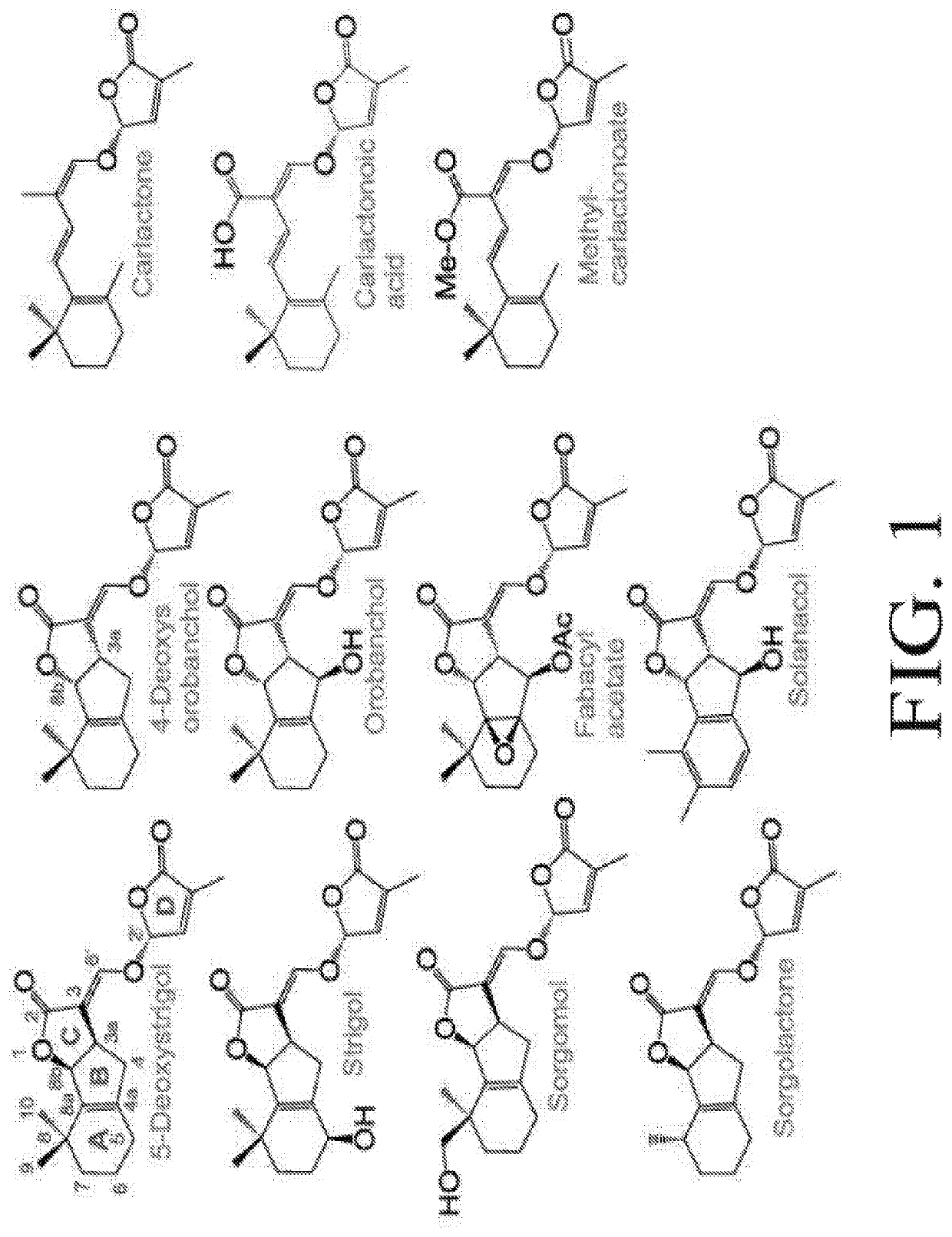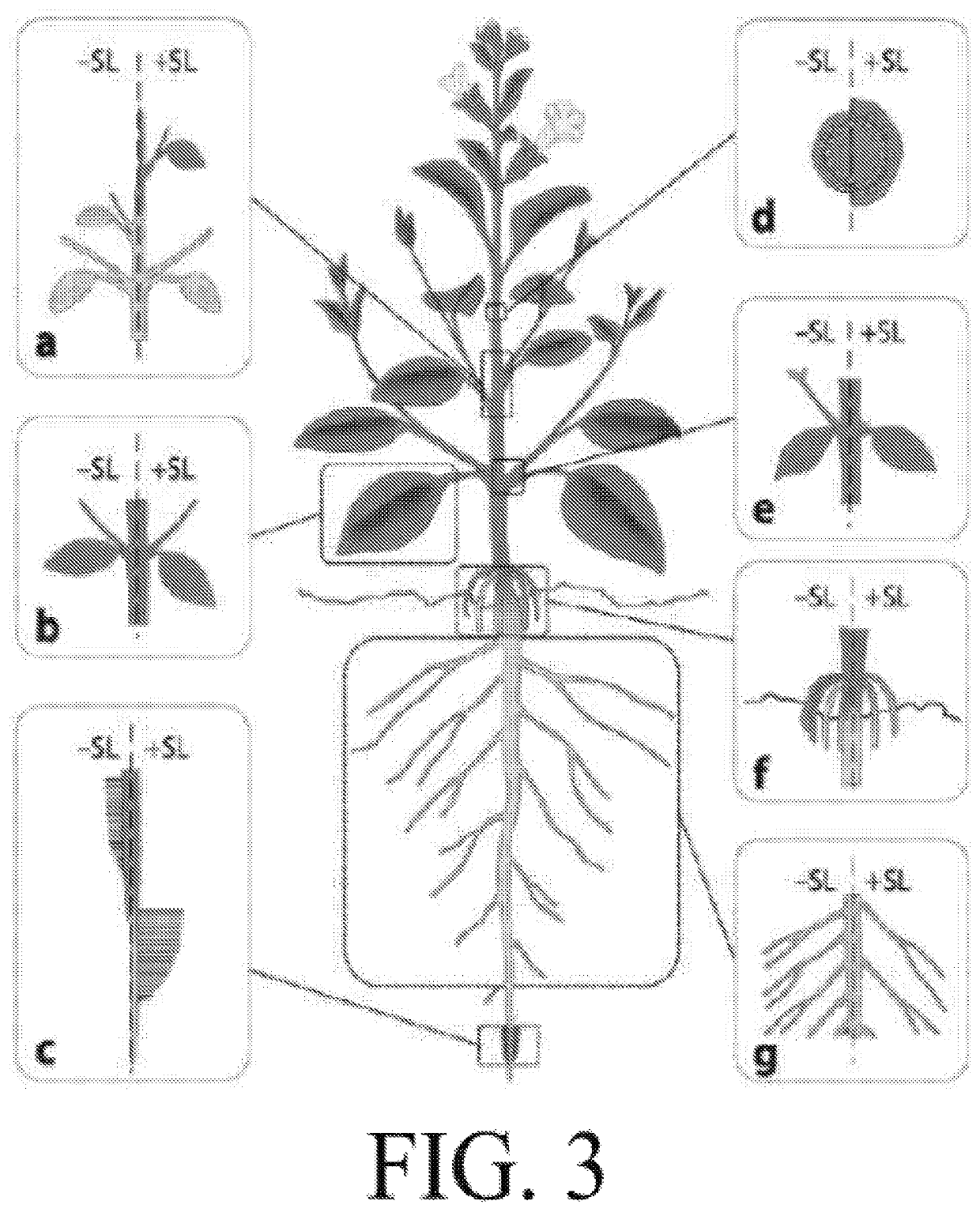Methods for controlling root parasitic weeds: inhibitors of seed germination in Striga
a technology of root parasitic weeds and inhibitors, which is applied in the direction of plant growth regulators, biocide, animal husbandry, etc., can solve the problems of large yield loss in many parts, hectares of farmland, and severe yield loss in different crops, and achieve the effect of inhibiting the germination of root parasitic plants
- Summary
- Abstract
- Description
- Claims
- Application Information
AI Technical Summary
Benefits of technology
Problems solved by technology
Method used
Image
Examples
example 1
[0070]X-ray crystallography was used to obtain high-resolution (1.2 to 1.7 Å) diffraction patterns of wild-type and active site mutant (S95C) ShHTL7 proteins, summarized by the data shown in Table 2 below. The phase problem was solved using molecular replacement methods. The 2FoFc electron density showed a small molecule compound bound in the ShHTL7 active site. Owing to the high-resolution of the data, this bound molecule could clearly be identified as Triton X-100 (hereafter referred to as Triton, unless stated otherwise), as illustrated in FIG. 5. Interestingly, Triton was only used briefly in the recombinant protein purification protocol, during Escherichia coli cell lysis. Triton was absent in all crystal structures of ShHTL7 when omitted from the purification protocol, confirming the origin and nature of this compound. Triton bound to the active site pocket that is built by helices α4-α5 and α6-α7, which form a stacked double V-like cavity, as shown in FIG. 5. The 4-(1,1,3,3-t...
example 2
[0073]Triton bound ShHTL7 specifically with high potency in vitro. Triton remained associated with ShHTL7 despite washes, dialyses and size exclusion columns with buffers without Triton, and despite extensive exposure to high concentrations of the synthetic SL GR24. Therefore, the association of Triton with ShHTL7 was expected to be very strong. A high affinity between Triton and ShHTL7 was apparent in assays where ShHTL7 was pre-incubated with Triton for 2 h or more, akin to the time of Triton treatment during cell lysis, as shown in FIG. 8. Following pre-incubation, a Kd of 31 nM between Triton and ShHTL7 was measured using intrinsic Triton fluorescence assays, the results of which are shown in FIG. 8A. Triton's association with ShHTL7 had about ten times higher affinity than that of ShHTL7 and GR24 (Kd of 440 nM). Following pre-incubation, a tight Triton-ShHTL7 association was also apparent in aggregation temperature increases in a Triton concentration-dependent manner, as shown ...
example 3
[0075]Germination bioassays were used to assess the potency of Triton in plants. Striga hermonthica seeds were prepared as discussed previously herein. Triton also revealed to be a potent germination inhibitor in vivo, with both 1.54 μM and 15.4 μM Triton X-100 significantly inhibiting GR24-induced S. hermonthica germination, as shown in FIG. 9A. S. hermonthica genome encodes for eleven HTL proteins. It has been shown that in A. thaliana lines transformed with different ShHTL cDNAs, the expression of ShHTL7 can trigger germination when exposed to picomolar concentrations of GR24 while other ShHTL proteins (ShHTL4, 5, 6, 8 and 9) were much less sensitive, displaying EC50 values of 0.01 to 0.15 μM for GR24. Thus, in principle, S. hermonthica germination in presence of 1 μM GR24 might be triggered by ShHTLs other than ShHTL7. To evaluate the likelihood of Triton to inhibit not only ShHTL7 but also other family members, structural homology models based on ShHT7 and ShHTL5 were built and...
PUM
| Property | Measurement | Unit |
|---|---|---|
| OD | aaaaa | aaaaa |
| pH | aaaaa | aaaaa |
| pH | aaaaa | aaaaa |
Abstract
Description
Claims
Application Information
 Login to View More
Login to View More - R&D
- Intellectual Property
- Life Sciences
- Materials
- Tech Scout
- Unparalleled Data Quality
- Higher Quality Content
- 60% Fewer Hallucinations
Browse by: Latest US Patents, China's latest patents, Technical Efficacy Thesaurus, Application Domain, Technology Topic, Popular Technical Reports.
© 2025 PatSnap. All rights reserved.Legal|Privacy policy|Modern Slavery Act Transparency Statement|Sitemap|About US| Contact US: help@patsnap.com



